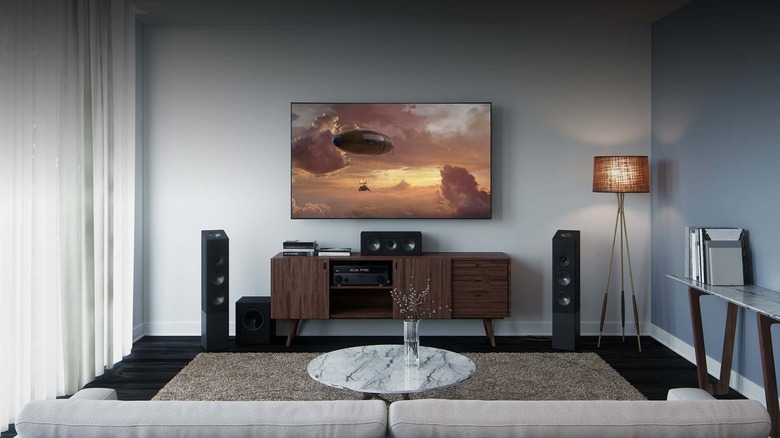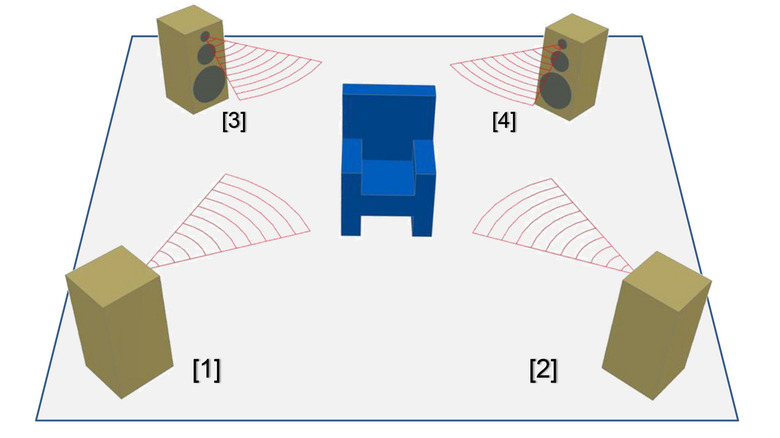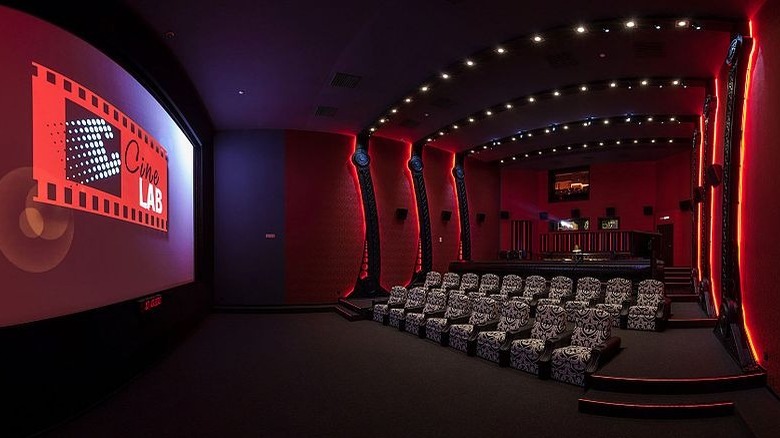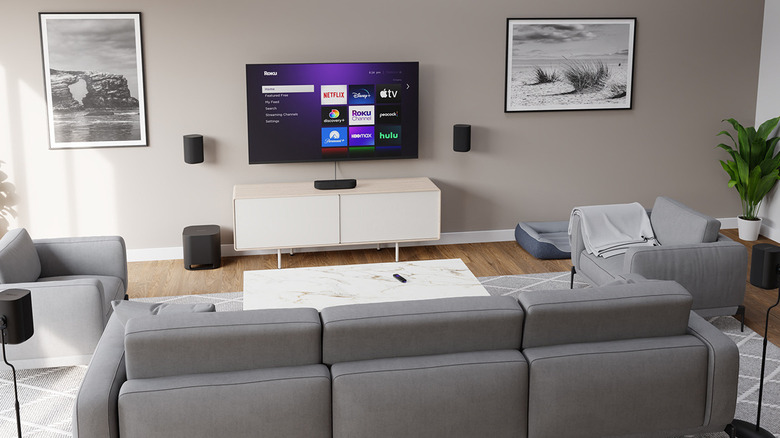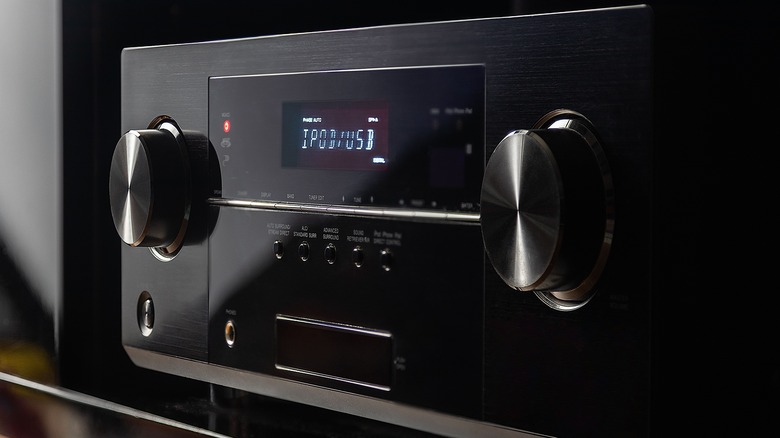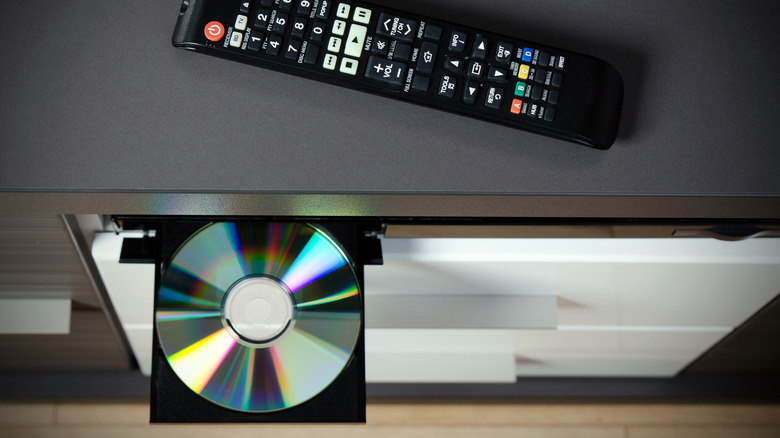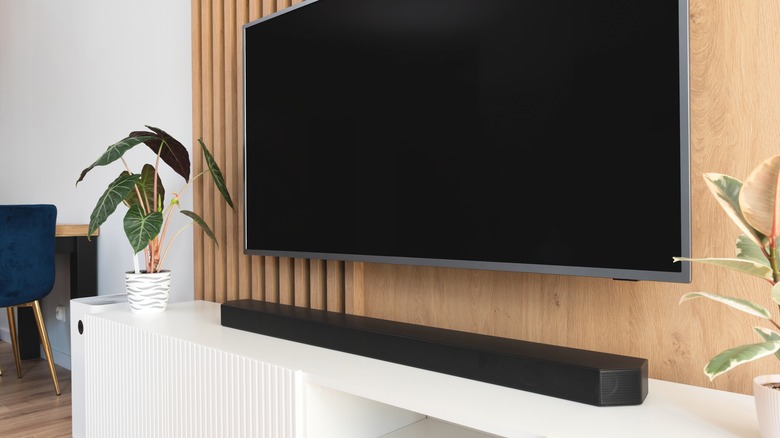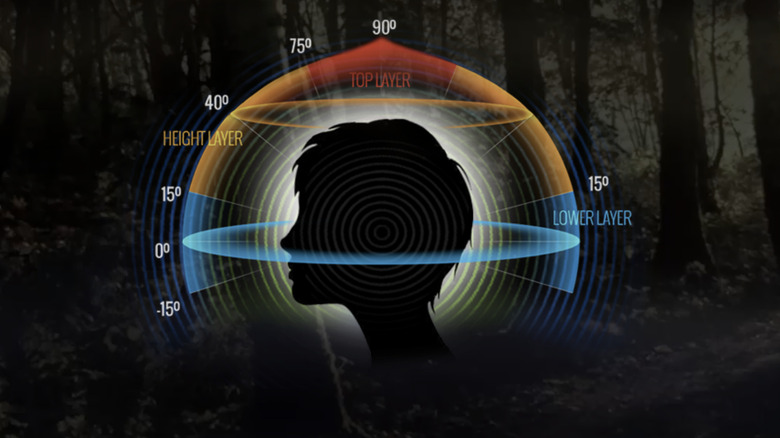Ultimate Guide To Surround Sound (And How It Works)
We may receive a commission on purchases made from links.
There was a time, not so long ago, when most of us were perfectly content with our 32-inch CRT screens and their tinny, built-in speakers. However, with the proliferation of affordable audio-visual gear and the development of new technologies, our standards as consumers have shifted. While surround sound used to be a novel feature reserved for cinemas and pro audio setups, it is now a common fixture in home entertainment systems everywhere.
Surround sound is just that: an immersive sonic experience for audio-visual entertainment, where sound is directed from all angles on a horizontal plane and, increasingly, from above, as a three-dimensional soundscape. This greatly improves the experience for the audience, as it places them front and center within the action, as the soundstage is divided into several distinct channels that better imitate a real live setting.
Here is our ultimate guide to surround sound, covering how it came into being, the many different surround sound configurations, and new and emerging technologies, including Dolby Atmos and DTS:X. We will also explain how surround sound facilitates such realistic and intricate sound reproduction and look at where the technology is headed in the future.
The early days of surround sound
Surround sound first entered the mainstream as quadrophonic audio technology in the early 1970s. Where mono recordings produce sound from a single channel, and stereo splits the sound into two, quadrophonic sound was divided into four distinct channels as a precursor to six-channel surround sound. However, it proved expensive and difficult to reproduce using the analog vinyl and tape formats of the time, so it didn't properly catch on until Dolby Laboratories developed surround sound for cinemas and applied this technology to home video as Dolby Surround.
Following the invention of the LaserDisc format, a larger bandwidth was available to reproduce sound across several channels. Dolby was quick to introduce the AC-3 (Dolby Digital) digital format in 1983, which could provide audio for five full bandwidth channels and a low-frequency effects (LFE) channel for a subwoofer. This evolved into Dolby Pro Logic, which could intelligently extract 5.1 surround sound from a regular stereo soundtrack.
1992's "Batman Returns" was the first film released in Dolby Digital format, followed by 1993's "Jurassic Park," which used DTS technology as an emerging rival to Dolby. With the introduction of the DVD in 1995, 5.1 surround sound was well on its way to becoming the standard for immersive home entertainment.
[Featured image by Wiki LIC via Wikimedia Commons | Cropped and scaled | CC BY-SA 4.0]
The components of surround sound
Surround sound is achieved by manipulating audio via various receiver and speaker configurations to create an immersive experience. These usually comprise a central speaker, several satellite speakers, and one or more subwoofers. The AV (audio-visual) receiver is an amplifier, similar to that on a home stereo system, that can divide the signal into as many as 13 distinct channels.
Surround sound setups typically involve a numerical descriptor for the distribution of their channels, such as "5.1" for the number of ear-level speakers relative to the number of subwoofers, which is a single unit in most home setups. Sometimes, in more complex systems, there is a third number, denoting height speakers, which are usually placed in the ceiling or are upward-firing, for example, in 7.1.2 systems.
While researching surround sound setups, you will come across many different configurations, including 2.1, 5.1, 6.1, 7.1, 9.1, and 11.1, as well as twin subwoofer systems, such as 5.2. Where a subwoofer is absent from the configuration, it is described with a zero, as with 5.0 systems. The subwoofer caters to the lower frequencies of 20 Hz to 200 Hz. It is usually positioned anywhere in alignment with the forward-facing speakers, as it doesn't need to be placed centrally within the stereo field. However, it is worth experimenting to fine-tune your home surround sound setup and find the optimal subwoofer location according to the size and shape of the room you plan to use.
[Featured image by Dirrtyjerm via Wikimedia Commons | Cropped and scaled | CC BY-SA 4.0]
How a typical 5.1 surround sound system works
5.1 setups have become the standard for home cinema systems and are generally referred to as six-channel setups. This is because the AV receiver divides the audio signal into six distinct sections — three forward-facing speakers (left, center, and right), two inwardly facing surround speakers to the left and right side, and a subwoofer — each with either a wireless or wired connection.
The three forward-facing channels of a 5.1 system are divided into a center channel for dialog and left and right speakers to create a wider stereo image. The two rear speaker channels are used for ambient sounds, which provide the immersive "surround" effect. The subwoofer handles the lower frequencies via the separately encoded LFE channel to complete the comprehensive soundstage.
Once a soundtrack is encoded for common formats, such as DTS 5.1 or Dolby Digital, an AV receiver can reproduce it as surround sound. Alternatively, modern technologies like Dolby Pro Logic II can recreate surround sound from a standard stereo signal, converting movies, streamed TV programs, video games, and music into a glorious 5.1 experience.
6.1 surround sound makes its debut
The march of technology never falters, and it wasn't long before improvements were sought to widen the soundstage of the 5.1 standard. The next step on surround sound's evolutionary ladder was 6.1 surround, which placed an extra rear speaker between the inward-facing left and right satellite speakers. This added an extra dimension on a horizontal plane, helping the audience gauge proximity as objects approached and retreated from behind the viewer.
While this appeared to be the natural progression for surround sound configurations, it proved confusing when brought to market, as manufacturers vied to create their own formats for 6.1 surround sound. Dolby Digital and THX combined resources to bring us Dolby Digital EX, which extrapolated the extra channel from the rear left and right speaker signals, whereas DTS produced encoded DTS Matrix, which worked similarly to Dolby Digital EX and DTS Discrete, creating a distinct sixth channel.
While 6.1 surround sound was an important stage in the development of modern surround sound, it was short-lived. Already, plans were being made for the next phase of eight-channel surround sound. Nowadays, seven-channel 6.1 systems have been largely consigned to history.
7.1 surround sound and the Blu-ray revolution
As emerging technologies, HD DVD and Blu-ray created new possibilities in sound reproduction, and eight-channel 7.1 surround sound provided an even more immersive experience for compatible systems. The extra storage of these new formats meant that more discreet channels could be provided, facilitating an extra two back surround speakers. This meant that viewers had a total of four ambient speakers in addition to the three forward-facing speakers and subwoofer.
The two extra speakers filled much the same role as the additional speaker in a 6.1 setup, but in stereo. Each channel was discreet, so 7.1 systems produced better depth, clarity, and dynamics. The amount of extra data required for 7.1 systems meant that there were limitations, and it was up to the studios to decide whether it was worth releasing movies in 5.1 or 7.1 surround sound. Again, Dolby and DTS produced several formats for 7.1 configurations to satisfy different media, using compressed "lossy" and uncompressed "lossless" formats.
Lossy versus lossless formats
With advances in encoding, better sound reproduction was now possible across multiple channels. However, as attractive as "one format to rule them all" may sound, it was not practical, as the amount of usable data was limited by streaming bandwidth or the available space on a Blu-ray disc. As such, the main developers of surround sound, Dolby and DTS, were forced to split their products into compressed and uncompressed formats.
Lossy formats have lower bitrates and, as such, are better for streaming video, as too much data can lead to interruptions from buffering. To this end, Dolby and DTS created Dolby Digital Plus and DTS-HD, respectively. While these provide higher bitrates and superior surround sound compared to their 5.1 counterparts, Dolby Digital and DTS 5.1, they pale in comparison to the lossless formats Dolby TrueHD and DTS-HD Master Audio. For example, Dolby Digital Plus has a maximum bitrate of 6 Mbps, compared to 18 Mbps for Dolby TrueHD.
It may take a particularly sharp pair of ears to discern the difference between lossless and lossy surround sound. However, it is a testament to the progressive nature of the industry-leading audio encoding companies, Dolby and DTS, that they strive for perfection while providing a practical solution to the data limitations faced by surround sound technology.
Recent developments in object-based surround sound
While 7.1 surround sound provided an unprecedented audio-visual experience, DTS and Dolby were far from done. Having explored many possibilities in sound design on a horizontal plane, it seemed the only direction to go from there was up, and each began developing sound design on a vertical plane. Thus began a new direction in surround sound, quite literally, with the introduction of "object-based" 3D surround sound technology.
As the name suggests, 3D surround sound offers a fully immersive surround sound experience across both the horizontal and vertical planes. For example, imagine an aircraft flying overhead, with the Doppler effect in full force, passing from behind you to above you and into the distance. It is referred to as object-based sound because it enables the sound designer to place an audible object anywhere within three dimensions.
3D sound is made possible with the latest developments in sound encoding from Dolby Atmos and DTS:X and ceiling-based or upward-firing speakers within the home entertainment system. As such, the standard name formatting required an extra digit, representing the number of vertical speakers. Hence, we are seeing descriptions like 5.1.2 and 7.1.4 creeping into surround sound configurations.
Creating the ideal surround sound setup
There are many factors to consider when choosing the ideal surround sound setup for your living space. These might include your room shape and size, budget constraints, and practical considerations, such as seating. If space and affordability are your chief concerns, Dolby Atmos and DTS:X soundbar/subwoofer combinations offer compact solutions that are often more affordable than a multi-speaker setup. Lots of major brands make soundbars, and the hardware has improved a lot in recent years.
If you decide to go for a fully immersive multi-speaker surround sound system, finding the ideal speaker placement can be a real headache, but it's very important. A typical surround sound setup can be divided into five elements: front speakers, surround speakers, rear speakers, height speakers, and subwoofer.
The front speakers do most of the hard work, and these should be placed at ear level, with the center speaker in the center (of course), and the left and right at around 30 degrees from the central seating position. The subwoofer should be placed in alignment with the front speakers. The surround speakers should be placed at ear level and face the listener from each side.
The rear speakers should also be elevated to ear level and turned slightly inward toward the listener. Height speakers are a little trickier and must be elevated high on a wall facing downward or, ideally, within the ceiling. Often, an upward-firing solution like Dolby Atmos helps circumvent those kinds of tricky installations.
The future of surround sound
As we've seen, the surround sound industry has been growing since the 1960s. Right now, we are seeing bigger leaps in surround sound technology than ever before, as more companies are vying for a market share of this growing industry and home entertainment continues to flourish in the digital age.
Dolby Atmos and DTS:X are currently the top two surround sound systems. However, emerging alternatives include IMAX Enhanced for object-based surround sound and MPEG-H, a highly dynamic codec that allows for personalization and interactivity within the soundstage. Meanwhile, Auro-3D remains popular in Europe and other territories as an audio codec that is effective not just in the home, but also in cars and mobile devices.
Additionally, new technologies like Audyssey DSX and DSX 2 are making waves, with extra channels for width and height for a cocoon-like audio-visual experience. At the same time, Dolby Pro Logic has made a return with its latest II, IIx, and IIz systems, which intelligently identify audio cues, such as ambient sounds, and channel them to create a more detailed sound reproduction.
Evidently, there is much more to come from the ever-changing, constantly developing surround sound industry. As surround sound solutions that are affordable, compact, and practical become more prevalent, they could well become as ubiquitous as television itself. However, how far they will go to improve on the existing highly immersive options remains to be seen in a world that is already pushing the boundaries of home entertainment well beyond what was thought possible just a few decades earlier.
